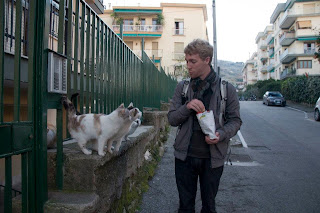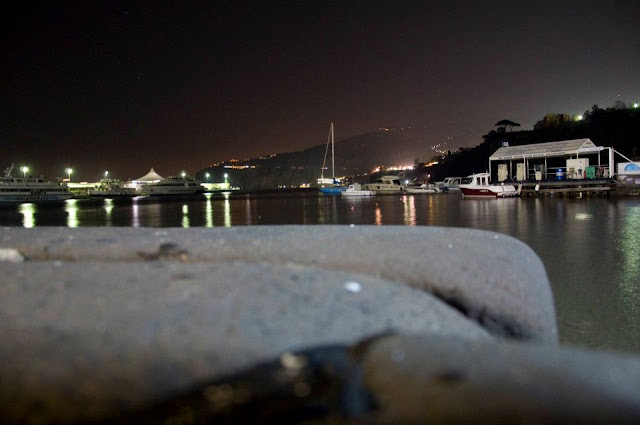Let's get our bearings straight first. Campania is the next region south from Rome's region of Lazio. The center of Campania is essentially Mount Vesuvius which lurks just off the coast from the Bay of Naples. Not surprisingly, Naples can be found on the north coast of the bay, Sorrento on the south coast and Pompeii lies directly between. My weekend included all three of these sites, starting with Pompeii.
My professor for Ancient History of Rome was taking his other class to Pompeii and back. He offered the open seats to my class and I jumped on it. It turned out that my roommate Adam was in his other class, so I immediately had a traveling buddy.
He was a little nervous since he had to give a big presentation that day about the Temple of Isis. He nailed it though! I learned quite a bit.
Pompeii is very interesting. One thing many people don't realize is that Pompeii is a complete city. It's close to three miles long and a mile wide and after 150 years of excavations, 25% of it is still buried. It's overwhelming. It has everything a city would have only Roman styled: Bath buildings, theaters, amphitheaters, apartments, shops, bakeries, and temples.
That being said, the wealth of knowledge at Pompeii is incredible. The eruption of Vesuvius in 79 A.D. took the city and froze it in time. Everything you see was exactly as it was on that exact day in history. Even plaster molds of bodies were made in their decomposed organic cavities to show victims' last breaths.
Every thing is frozen in time. Not only are the important monuments preserved, but the apartments and houses, which would normally be torn down over time, are preserved as well. This helps illuminate the everyday life of Romans at the time. Freakishly, it appears to be very similar to the way Roman's live today. For instance, we have this ancient snack bar which looks almost identical to snack bars in Modern Rome.
There were also political advertisements written on the walls.
There were flour grinders, ovens and olive and wine presses.
Even the streets look strikingly familiar to any street in modern Rome.
You can see that, although the world has completely changed in the past 2000 years, many of the basic city layouts have stayed the same. It provides a neat sense of connection to an ancient civilization based on the unwavering necessity of basic human-interaction.
Pompeii was simply fascinating. The, still active and ready to go off in the next 20 years or so, Mount Vesuvius can be seen rising out of the haze from just about every street, and it constantly reminds you of the mortality around you.
I thought that the amphitheater was the most impressive monument. Standing in the middle of the arena gave it a very archaic feel.
We were just finishing our tour in the early afternoon. The beautiful Campania sun was starting its way down. The weather was spectacular. It was warm, a little humid, and just a tad breezy. Everywhere around us was hazy. It made everything seem very cozy. I met my friend Samantha and said good-bye to Adam. Samantha and I were going to meet Joe and spend the night a half-hour away in Sorrento. So we headed over and waited for the train.
The train to get into Sorrento was entertaining. The terrain was very rugged and the tracks never settled out onto flat land for more than a second. We were alternating through tunnels and over bridges with beautiful views of valleys and mountains. Finally we arrived in Sorrento and went to check-in to our bed and breakfast only to discover that the internet made a mistake. Damn technology. Fortunately, we were upgraded for free to the hotel across the street with a balcony that looked out over the mountains. Can't complain.
Sam and I decided to walk around for a little. I grabbed the free bag of potato chips and ate them on the way. This attracted a pound of cats.
(Credit: Samantha Wiess)
We kept walking and came to a beautiful overlook of the peninsula with the island of Capri hovering over the haze. An older Italian fellow mentioned that the moon has that upward-facing crescent shape only once in every long while. Neat! I have to use Sam's picture since she is an expert photographer.
(Credit: Samantha Wiess)
Gorgeous! We were waiting for Joe to get in, ETA 22:45, and it was only sunset. So, we continued to walk around and down to the bay. I had to touch the water since it was my first time to the Mediterranean! On our way we bought a couple of oranges and some local wines. We got down, had a seat and enjoyed an orange and the beautiful evening we were having.
(Credit: Samantha Wiess, again)
Finally, Joe got in and we had dinner. Thank goodness, we were starving. I had the Gnocchi alla Sorrentina, and it was to die for. When you're traveling, always sample the local specialties. Simple as that. We headed back and the place was dead quiet. A nice change of pace from the loud streets of Rome.
The next morning we woke up early and had a hotel breakfast.
This would become the day of random alcohol experiences. We started the day by walking through an orange and lemon grove. On our way out, the lady asked us to sample her limoncello, essentially alcohol made from lemons. Supposedly it's good for digestion. Nothing better to do at 10 in the morning. They made their limoncello from the lemons of the trees that we had just walked under. It was delicious.
Sam decided to go swimming in the Bay of Naples. I think she immediately regretted the decision. Now however, she's probably glad she went. It did look pretty cold, though. We spent the rest of the morning relaxing and waiting for our 2 o'clock ferry to Naples. I did some drawing.
Then, it was off to Napoli!
The view was amazing: The cliffs, the towns, the mountains, Naples, Vesuvius. The sun was beautiful. The water was relaxing. Something about the water, and being on a boat especially, always relaxes me. It reminds me of our lake house back home.
Naples is amazing. After all of the pick-pocket stories, the mafia movies, and news about the garbage strikes, I never felt scared, disgusted or disappointed.
Naples is huge! There are people everywhere going somewhere, driving like maniacs, and smoking like they're at war. Total chaos. But, chaos can be beautiful, and Naples proves it. Naples is certainly dirty. How can it not be with millions of people living on top of each other? But it's dirty in a good way. Furthermore, they make up for it with their culture. Neapolitan people look completely different from other Italians, talk differently and behave differently too. They truly are their own.
I'll admit that I had held on to my camera with white knuckles for the first couple of hours after hearing all the horror stories, but I loosened up after a while and got a few good photos.
The best part, of course, was the pizza. Simply the best pizza I've ever had. It was the cheapest meal I've had in Italy and possibly best tasting. The atmosphere of the pizzeria matched the one outside: claustrophobic and chaotic. Our waiter was rude to begin with but warmed up after I told him "Era squisita!" about our meal (it was exquisite). When it comes to food in Italy, compliments are very welcome and almost always deserved.
We finished our meal and realized we were the only ones in the pizzeria. Strange, it was 4pm. That's because, unlike Rome, Naples takes their ripossino very seriously.
That is why I love Naples. Rome is a big city and behaves like a big city. Perugia is a small town and behaves like a small town. Naples is a massive city but it behaves like a small town. It's charming.
We wanted dessert and we were lucky to find one little shop still open. The thing to get in Naples is the baba. I still don't know what it is exactly. I ordered one and before she handed it to me, she opened a bottle of rum from under the counter and splashed it on top. Didn't see that one coming. It tasted like a shot of rum chased with a glazed doughnut. Interesting.
We were getting exhausted, and there was only one more stop (which means one more thing to read about. Sorry, these posts have been getting longer): The Museo Archeologico di Napoli. We had to stop here because just about every movable object from Pompeii has been taken there. Even the ones that you wouldn't guess were movable. For one, this mosaic. It depicts Alexander the Great defeating the Persians. This was someones floor in Pompeii made from thousands of little carved stones a quarter inch across.
Alex is on the left, looking sexy, and everyone else is a Persian. Let's just say he was a real bad-ass.
They also had, on display, dentistry and surgical utensils. Again, freakishly similar to modern equipment, minus the electricity.
The most interesting part was the artifacts gathered from the Pomeii brothel. Yes, that's right. Everything found there had phallic imagery involved. The frescoes and mosaics depicted women raping men and other strange sexual activity. The funny thing about this was that they had dedicated an entire room of the museum to the objects found in the brothel. Therefore, this link is for mature audiences only.
Like I said, Pompeii was a complete city.
On that note, Naples was finished. Damn good city. It's too bad they get such a bad rap.
Our train left at 8:30 and as we were sitting in the train station, an Italian started to talk to us. He was military, stationed in Rome, visiting with his family in Naples. He asked about how we liked Naples. I told him I loved it and that I'll be back again sometime.





